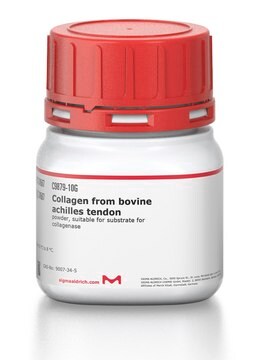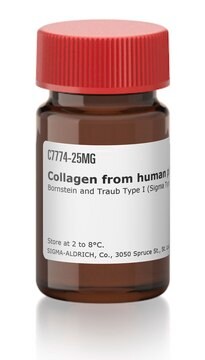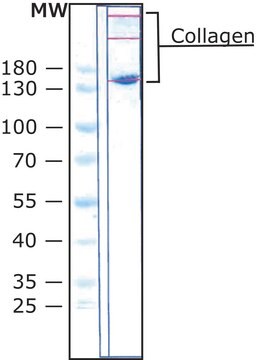C9791
Bovine Collagen Type I
from bovine skin, powder, suitable for cell culture
Sinônimo(s):
Type I collagen
About This Item
Produtos recomendados
product name
Collagen from calf skin, Bornstein and Traub Type I, solid, BioReagent, suitable for cell culture
fonte biológica
bovine (calf) skin
Nível de qualidade
linha de produto
BioReagent
forma
solid
embalagem
poly bottle of 10 mg
poly bottle of 100 mg
poly bottle of 250 mg
poly bottle of 50 mg
técnica(s)
cell culture | mammalian: suitable
cobertura de superfície
6‑10 μg/cm2
solubilidade
0.1 M acetic acid: 1 mg/mL (Allow to stir at room temperature 1-3 hours until dissolved.)
nº de adesão UniProt
Especificidade de ligação
Peptide Source: Fibronectin
Peptide Source: Laminin
Condições de expedição
ambient
temperatura de armazenamento
2-8°C
Informações sobre genes
bovine ... COL1A1(282187)
Procurando produtos similares? Visita Guia de comparação de produtos
Categorias relacionadas
Descrição geral
Aplicação
- as a component of collagen gel matrix for culturing preantral follicles
- as a component of Roswell Park Memorial Institute, for culturing gilthead seabream kidney leukocytes and macrophages and acidophilic granulocytes
- to coat transwells prior to seeding of epithelial cell culture
Ações bioquímicas/fisiológicas
Componentes
Nota de preparo
Outras notas
Código de classe de armazenamento
11 - Combustible Solids
Classe de risco de água (WGK)
WGK 1
Ponto de fulgor (°F)
Not applicable
Ponto de fulgor (°C)
Not applicable
Equipamento de proteção individual
Eyeshields, Gloves, type N95 (US)
Certificados de análise (COA)
Busque Certificados de análise (COA) digitando o Número do Lote do produto. Os números de lote e remessa podem ser encontrados no rótulo de um produto após a palavra “Lot” ou “Batch”.
Já possui este produto?
Encontre a documentação dos produtos que você adquiriu recentemente na biblioteca de documentos.
Os clientes também visualizaram
Artigos
Cancer stem cell media, spheroid plates and cancer stem cell markers to culture and characterize CSC populations.
Extracellular matrix proteins such as laminin, collagen, and fibronectin can be used as cell attachment substrates in cell culture.
Nossa equipe de cientistas tem experiência em todas as áreas de pesquisa, incluindo Life Sciences, ciência de materiais, síntese química, cromatografia, química analítica e muitas outras.
Entre em contato com a assistência técnica










